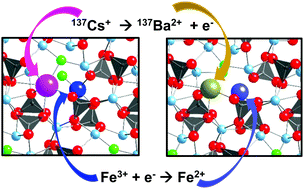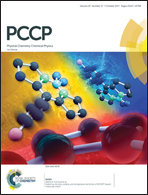Beta transmutations in apatites with ferric iron as an electron acceptor – implication for nuclear waste form development
Abstract
Apatite-structured materials have been considered for the immobilization of a number of fission products from reprocessing nuclear fuel because of their chemical durability as well as compositional and structural flexibility. It is hypothesized that the effect of beta decay on the stability can be mitigated by introducing an appropriate electron acceptor at the neighboring sites in the structure. The decay series 137Cs → 137Ba and 90Sr → 90Y → 90Zr were investigated using a spin-polarized DFT approach to test the hypothesis. Apatites with compositions of Ca10(PO4)6F2 and Ca4Y6(SiO4)6F2 were selected as model systems for the incorporation of radionuclides Cs and Sr, respectively. Ferric iron was introduced in the structure as an electron acceptor. Electron density of states, crystal and defect structures, and energies before and after beta decay were calculated. The calculated electron density of states suggests that the extra electron is localized at the ferric iron, which changes its oxidation state and becomes ferrous iron. The crystal and defect structures were analyzed based on the volume, lattice parameters, radial distribution functions, metal cation to coordinating oxygen distances, and the metaprism twist angle of the apatite crystal structure. The results show that there are minor changes in the crystal and defect structures of CsFeCa8(PO4)6F2 with Cs+ and Fe3+ substitutions undergoing the Cs → Ba transmutation, and of Ca3SrY4Fe2(SiO4)6F2 with Sr2+ and Fe3+ substitutions undergoing the Sr → Y → Zr transmutations. The last decay change, from Y3+ → Zr4+, causes relatively larger changes in the local defect structure around Zr involving the coordination environment but the change is not significant to the crystal structure. The results on calculated cohesive energy suggest that the transmutations Cs+ → Ba2+ and Sr2+ → Y3+ → Zr4+ in both apatite compositions are energetically favorable, which is consistent with the minor structure distortions. Increased stability with favorable energetics and structural distortion by incorporating ferric ion is significant with respect without variable valence ions. The results confirm the structural and compositional adaptability of apatites upon beta transmutations. The study suggests that apatite-structured materials could be promising nuclear waste forms to mitigate the beta decay induced instability, by incorporating variable valence cations such as ferric iron in the structure. The study demonstrates a methodology which evaluates the structural stability of waste forms incorporating fission products undergoing beta decay.



 Please wait while we load your content...
Please wait while we load your content...